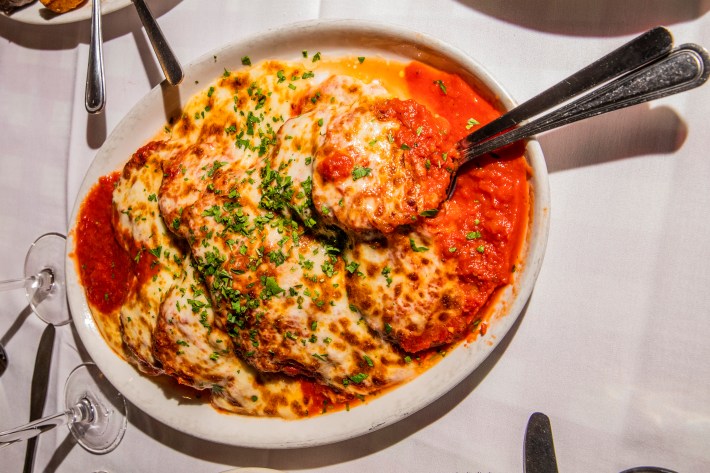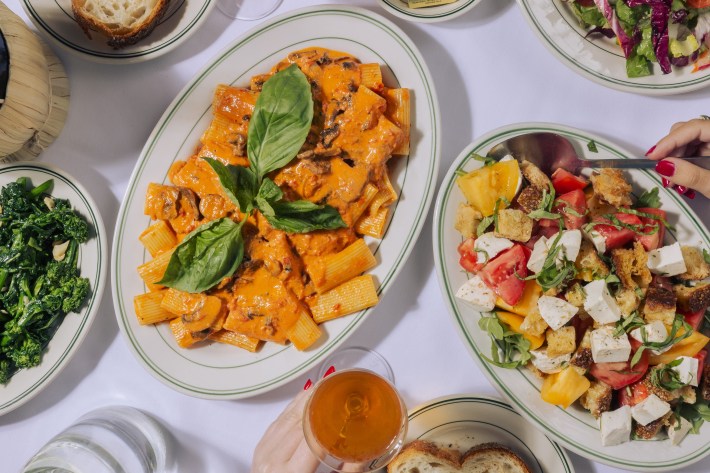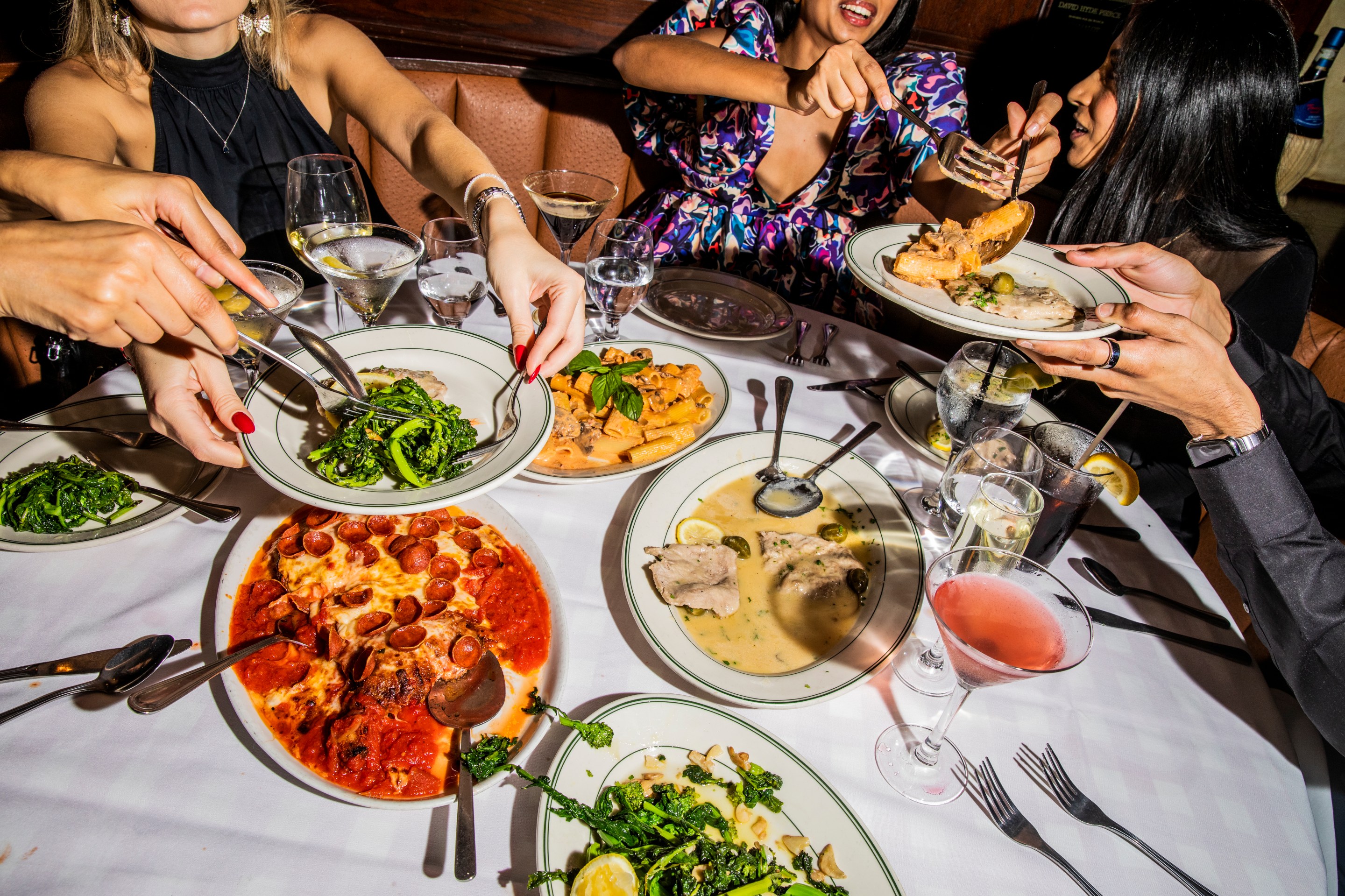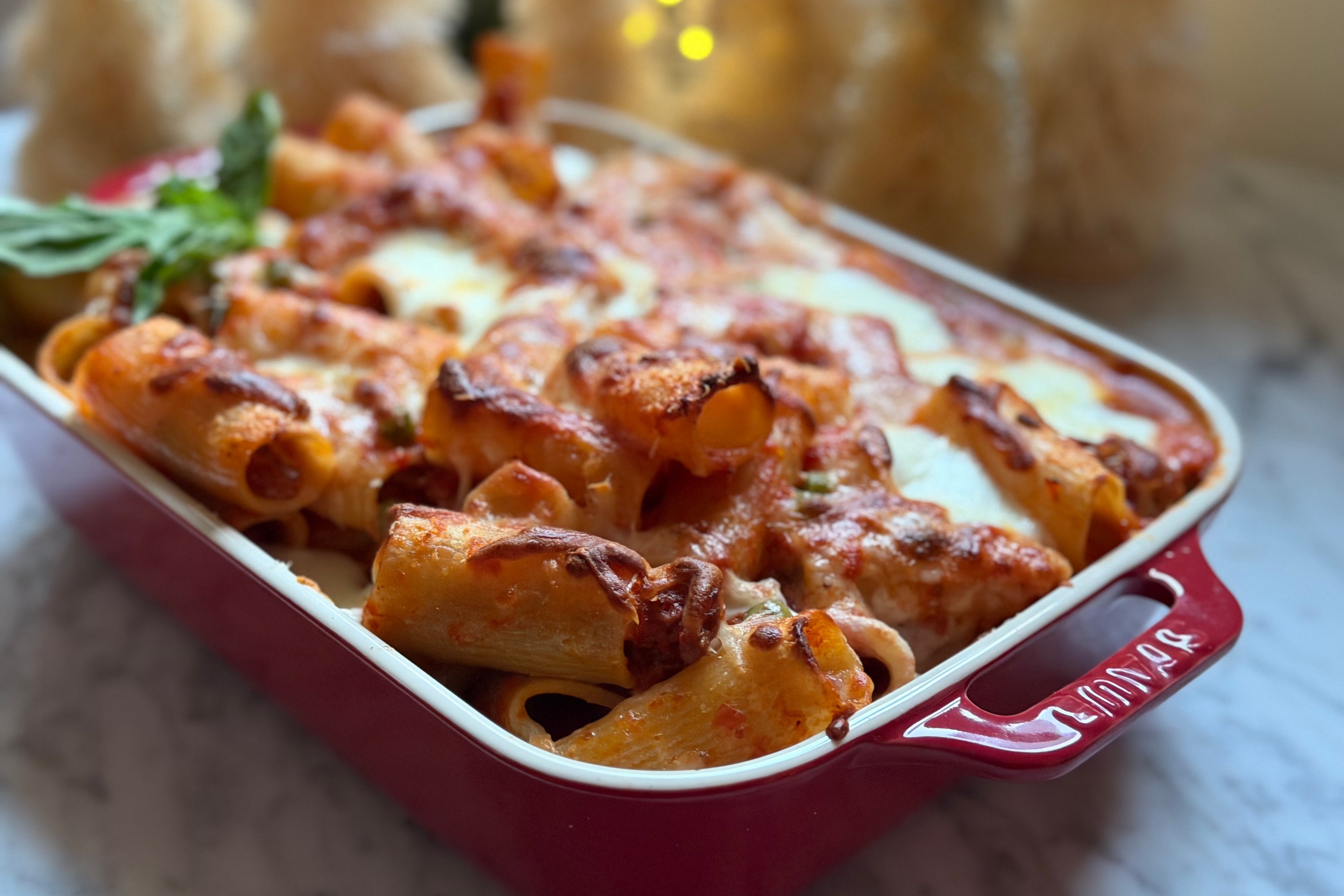Every night in Manhattan’s Greenwich Village, hundreds of people take their place at tables at Don Angie, Carbone, and Arthur & Sons, to name three of the city’s most sought-after Italian-American tables. Reservations are fought for and secured weeks in advance. Meanwhile, in Times Square and the Upper East Side, the two sprawling locations of Tony’s Di Napoli probably serve more customers than all three of these hit restaurants combined. By now, you may be asking, “Tony’s Di Wha?”
Tony’s Di Napoli is an unusual success story, with the first location opening in 1990, followed by the Times Square offshoot in 2002. The Wetanson family that owns it is (a) not as well known as the Major Food Group or other buzzy Italian-American owned and run joints; (b) Jewish, as in, not Italian; and (c) better known as the owners of the Dallas BBQ chain. Yet they have created not one but two red sauce joints that attract loyal, large crowds, and while they may not get much notice from major media organizations or food awards organizations, a steady stream of visitors find them on OpenTable or via TripAdvisor, where the Times Square location (listed as Midtown) is ranked #107 out of more than 7,000 restaurants in New York City. Not Italian-American restaurants, all restaurants.

Toward the end of my wide-ranging interview with Wetanson, the subject of Carbone and other hot spots comes up, and he raves about his more glamorous competitors. He talks about his admiration for the Major Food Group’s concepts beyond Carbone, and says, “I think they're the best in the business. They're good employers. I have nothing bad to say about them.” That’s high praise coming from Wetanson, a fourth-generation restaurateur who has helped the already successful family business go into overdrive, with 10 Dallas BBQ locations—another will open this month in Brooklyn, and a 12th is under construction in New Jersey—the two Tony’s Di Napoli, and more in the pipeline.
****
I first met Wetanson at that Times Square location of Tony’s Di Napoli. My Italian-American mother and stepfather, visiting from Florida, were staying on 42nd St., in town to take my kids to a Broadway show. I would not have had much luck securing a table for six at Carbone on a Saturday night, but Tony’s could accommodate me and about 400 others in its cavernous dining room on 43rd St. Not only that, but as I soon found out, the quality of the food and drink is in the same ballpark. I don’t know if anyone has ever said “Thou shalt not judge a restaurant by its rigatoni alla vodka,” but I had the dish at both Carbone and Tony’s Di Napoli within a few weeks, and Tony’s measures up to Rich Torrisi and Mario Carbone’s famous preparation—albeit without as much heat.
Not only that, but everything my family shared at Tony’s was delicious, from the baked clams and chicken parm to the broccoli rabe and spaghetti and meatballs. The service was helpful and attentive. The house Chianti, poured from straw bottles but of surprisingly good quality, flowed. The noise level pre-theater was loud, but it conveyed a sense of conviviality, and it became more subdued as diners headed off to see their shows. To conclude our dinner, we had ricotta cheesecake, cannoli, and tartufo—all exemplary. I’ve eaten in NYC Italian restaurants hundreds of times, and for a place named for a non-existent guy named Tony from Napoli, which is actually overseen by a guy named Stuart from Long Island, well, let’s just say I was getting intrigued.

The next time I met Wetanson was in a booth at the Upper East Side location of Tony’s. Unlike its offshoot, the original has lower ceilings and spreads its many tables around a closed-in kitchen area. (It’s actually the second version of this Tony’s; the first, on 2nd Ave., was reclaimed by the city under eminent domain to create the 2nd Ave. subway line. The current spot opened in 2011.) The layout creates a warren of dining rooms, but the concept is the same as Times Square: all dishes served family style (with half portions available), and big tables to hold all that food and seat all those people—between 1,000-1,500 covers per night at each location during peak times of the year, he says.
Wetanson, whose grandfather Herb and great-grandfather Carl ran a burger chain Wetson’s, in the 1950s, grew up at the family’s Dallas BBQ locations around the New York City area, and at Tony’s Di Napoli. As a teen, he helped his father Greg in every aspect of the operations, which inspired him to study hospitality; Stuart holds a degree from the Cornell School of Hotel Administration at Cornell University.
Since joining the leadership team of the family’s restaurants—the company culture eschews titles, he explains, though if pressed he’d call himself one of its principals—he’s helped build on Dallas BBQ’s success, while making tweaks to Tony’s Di Napoli meant to evolve the brand while maintaining its loyal following. He admits in our conversation that plans for a third Tony’s, likely in an NYC suburb, is in the works—a line of Tony's Di Napoli pasta sauces to be sold at retail is also on the way.
Before I can ask Wetanson a question, though, he insists on taking me to the kitchen to meet some of the staff, and introduces me to several cooks who have worked for the family for a dozen years or more. When we sit down, the general manager stops by and says that he’s known Stuart since he was “in his mother’s arms.”
Wetanson discusses his family’s tricks to achieving business longevity, maintaining loyal employees, how the company runs small restaurant-style kitchens in very big restaurants, plans for the future, and more. I’ve divided into a few sections, condensed and edited for clarity but in Wetanson's own words, below.
On the Origins of Tony’s Di Napoli
The recipes and the concept’s genesis was a passion project between my dad and my grandfather, who in the late 1980s and early ‘90s were still finding their stride together as partners. My grandfather had been in the industry already for many years. My father was young and up and coming. They were successful at Dallas BBQ, but they both felt a desire to prove themselves in a more cuisine-based, higher-end restaurant environment. They were very passionate about this style of food, both cooking it and eating it, and spent a lot of time at [legendary Italian-American Queens restaurant] Don Peppe. Don Peppe’s was the family gathering place. My dad grew up spending time in the kitchen [during] family parties. So, Tony’s was opened from day one as an Italian-American restaurant; it was meant to be a red-sauce Italian restaurant.

It was completely different from the Dallas BBQ business. There were years and years of my father and grandfather in the kitchen, letting literally every dish pass through their own fingers. They started with a lot of older, more seasoned, mostly Italian cooks and chefs and basically rebuilt from the inside-out with their own self-trained, mostly Ecuadorian cooks. At one point, my father, in his early 20s, cleared house and took their best cook slash dishwasher, who was a young hard-working guy named Andres Senago, and trained him to do the whole menu. And now, 30 years later, he's the head chef at both locations, and he is a brilliant leader and an excellent chef.
On Revamping Tony’s Di Napoli
Tony’s is a very slow-moving ship. It's a ship that's naturally resistant to change and will only take change if it's good change.
Since I got on board, there’s been some revamping of touchpoints: menu layouts, the way we do specials, our wine list, some plating, little things.
Dallas BBQ takes up a lot of all of our time. It's a big animal and it's a bigger company. And so there were a few things that have kind of been looked past over time with Tony's. It needed a little revamp, which I think we gave it and now we're doing it again.
On the Family-Style Menu and Food
Family-style is super efficient for the kitchen. You're putting out less plates of food for more people. You're looking at restaurants that are, you know, 300-400 seats. So we can put out better food, hotter food, more efficiently. And it's a better value for the customer.
There's an owner here pretty much every day. We're very strict about things being made to order. The chicken is cooked to order. Sauces made every day. So there's a freshness component.
On Dietary Restrictions
This menu actually lends itself really well to gluten-free, as we offer a gluten-free pasta. We have a lot of protein-centric dishes that are naturally gluten-free: steaks, chops, chicken dishes. Pretty much everything on the menu can be done in a gluten-free way. Vegetarian and vegan, too. My sister [who also works in the family business] was vegan for like 10 years and she would attest to Tony’s being one of the best vegan places you could possibly eat at. We have a huge list of sides and pastas, and a couple of vegetable-forward dishes. I mean, unless you get into protein alternatives like tofu and tempeh, there's really nothing better.
On the Company Culture
This is a people business and we treat people really well. We're an employee-first mindset company. Dallas BBQ is actually employee-owned. Tony's is not. It goes to show you how we want our employees to be invested in the success of the business. We help people build families. We've always taken care of people. Our wait staff specifically has a very sales-focused, commission-focused job that is different from most restaurants. We have a support staff system where everyone is motivated by the sales of the house, but people are also motivated personally. And that's worked very well for us.
On the Made-Up Name
Occasionally, people are a little let down by the lack of a Tony. Ironically, we have at least five or six Tonys working here, so that gets a smile out of customers when they ask about the name.
On the Décor
Both stores have a very different décor. It's an ode to how old, one-off family-style Italian restaurants usually have a theme to the decor that's around some kind of hobby. So like Don Peppe’s is horse racing memorabilia. And at Tony's, Herb, my grandfather, is an avid car collector and racecar driver. He's raced cars since the ’50s. At the front door, you'll see trophies and photos from back in the day at Le Mans and Sebring. In the dining room, it's classic cars, racing photographs, and headshots of all the famous drivers that Herb raced with back in the day.
Times Square on the other hand, it's all about Broadway. We have one of the best walls of fame in the area. Over 50 commissioned oil characters from artists. All the people who are honored have been to the restaurant and were presented a copy of the work. It’s a who's who: Hugh Jackman, Jersey Boys, Whoopi Goldberg, Mario Lopez—anyone who's done a big show opening pretty much has been honored at Tony's. We do a little cast party, usually around the opening.
On the Drinks
We do a lot with Tony's house Chianti. It's a one and a half liter straw bottle, custom bottled for us by Rocca della Macie in Tuscany. We also do a lot of old-school New York martinis and espresso martinis. There's a pretty big wine list. I think we're probably around 50, maybe 75 bottles. It's not massive, but it’s approachable. Our wine list doesn't go over $200-$300. We have some nicer Brunellos and Barolos.
On Future Plans
We’re very restrained about over-expanding Tony's. We want it to stay special. It's very much held on a pedestal right now. It's something people really cherish and appreciate for what it is. And if there was one in every mall and every suburb, I don't think it would keep that specialness. That said, we're actively pursuing the next location. There's a few areas on our map. Florida is possible. Long Island’s North Shore and Gold Coast. Bergen County is possible. Upper West Side. Downtown Manhattan. Tribeca. The team needs growth, Tony's has been around 30 years. We have a lot of employees who have been here 20-25 years and people are hitting a glass ceiling if we don't grow, so we need to grow to provide a path for the staff.
Tony's Di Napoli, 147 W. 43rd St., NYC, 212-221-0100, and 1081 3rd Ave., NYC, 212-888-6333, @tonysdinapoli, tonysnyc.com







